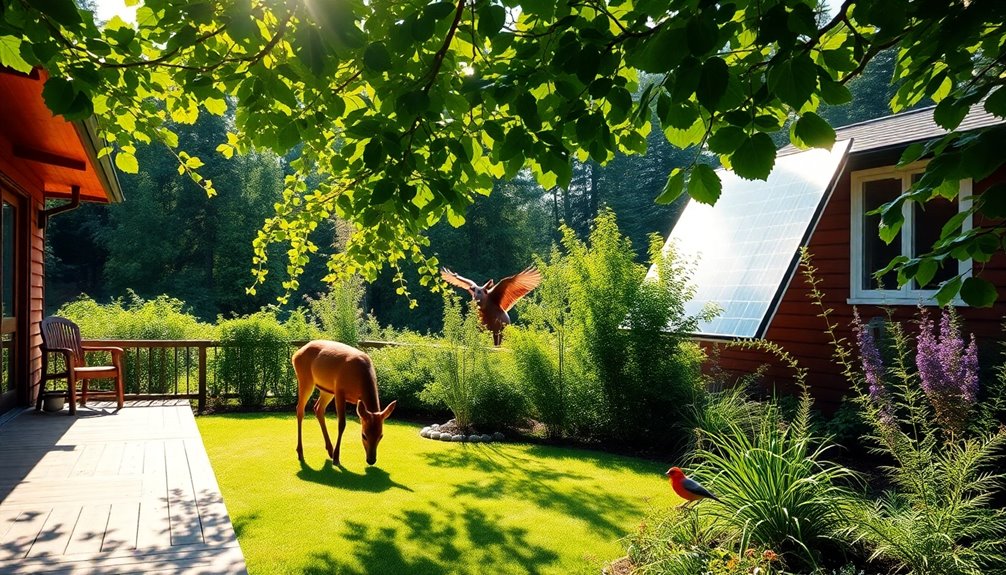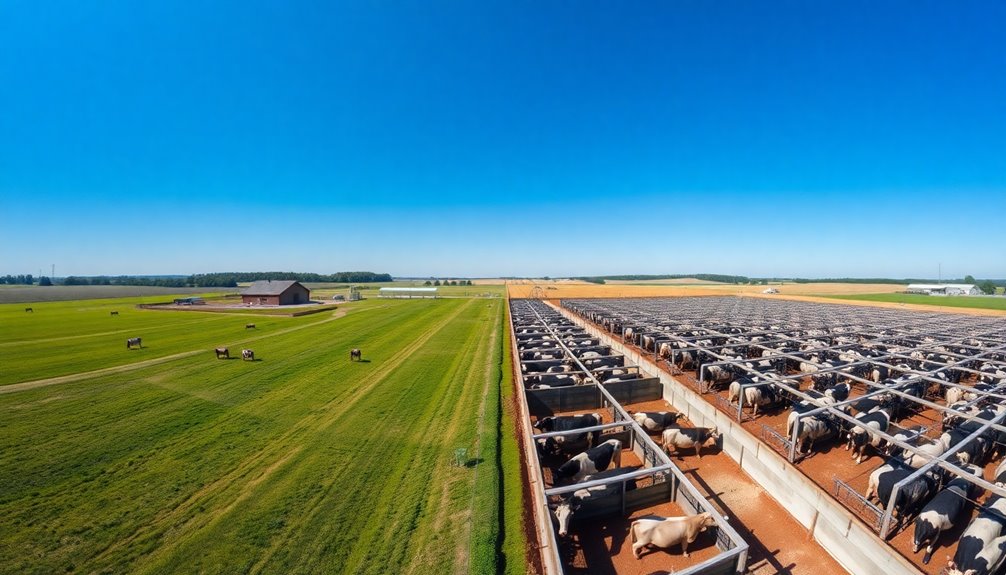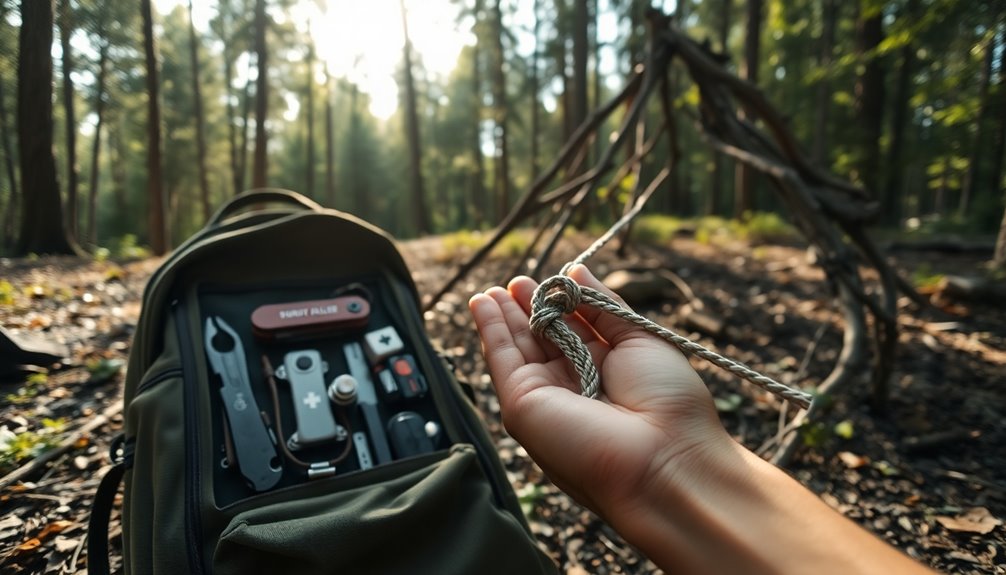To coexist with wildlife in your sustainable home, start by incorporating native plants to create habitats that attract beneficial species. Use wildlife-friendly landscaping, like hedgerows and water features, to offer food and hydration sources while ensuring safe animal passage. Avoid using chemical pesticides and non-toxic materials to minimize harm to the environment. Observe local wildlife without feeding or disturbing them, fostering respectful interactions. Implement practical solutions like wildlife corridors and fencing that allow coexistence. Embracing these practices can enhance your space and ecosystem, leading to a more harmonious living experience. There's much more to discover about this balance.
Key Takeaways
- Incorporate native plants in your landscaping to support local wildlife and promote biodiversity while minimizing the need for chemical pesticides.
- Design wildlife corridors and use wildlife-friendly fencing to allow safe animal passage and reduce human-wildlife conflicts.
- Install birdhouses, bat boxes, and water features to provide habitats and hydration sources for beneficial species in your sustainable home.
- Educate yourself on local wildlife behavior to foster responsible interactions and create a harmonious living environment without dependency on human food sources.
- Engage with local wildlife organizations for education and resources on best practices for coexistence and conservation in your off-grid lifestyle.
Introduction
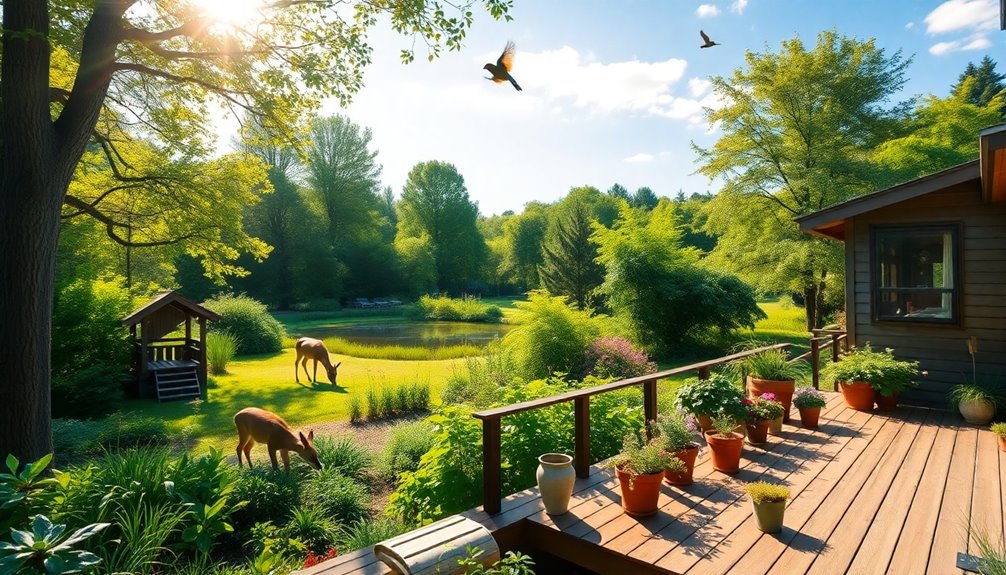
When designing your sustainable home, consider how wildlife can coexist alongside your living space.
By incorporating wildlife-friendly features and promoting harmonious interactions, you can create a thriving environment for both your family and local fauna.
Understanding these principles not only enhances your home but also supports ecological balance in your community.
Wildlife-Friendly Home Design Principles
To create a truly sustainable home, you should consider design principles that coexist harmoniously with local wildlife.
Start by incorporating native plants into your landscaping to create a wildlife habitat that supports biodiversity and benefits pollinators.
Design your home with wildlife corridors—pathways or tunnels—so animals can safely navigate the area without disrupting your activities.
Use non-toxic materials and eco-friendly building practices to minimize your environmental impact and protect local wildlife from harmful chemicals.
Installing birdhouses, bat boxes, and owl nesting sites encourages beneficial species, aiding in natural pest control.
Lastly, implement rainwater harvesting systems; they conserve water while creating additional habitats for wildlife, enhancing biodiversity around your home.
Promoting Harmonious Wildlife Interactions
Creating a wildlife-friendly home is just the beginning of fostering a balanced relationship with nature. By planting native species and providing natural shelters, you enhance biodiversity and create a habitat for local wild animals.
Allowing trees to stand partially supports various wildlife and contributes to healthier ecosystems. Observing wild animals from a safe distance minimizes their stress and helps you understand their behaviors and needs better.
It's crucial to avoid feeding these animals, as it prevents health issues and dependency, encouraging them to rely on their natural foraging instincts.
Lastly, educating yourself and others about local wildlife behavior fosters responsible interactions and reduces the likelihood of human-wildlife conflicts, ensuring a harmonious coexistence in your sustainable home.
Wildlife Habitat Importance
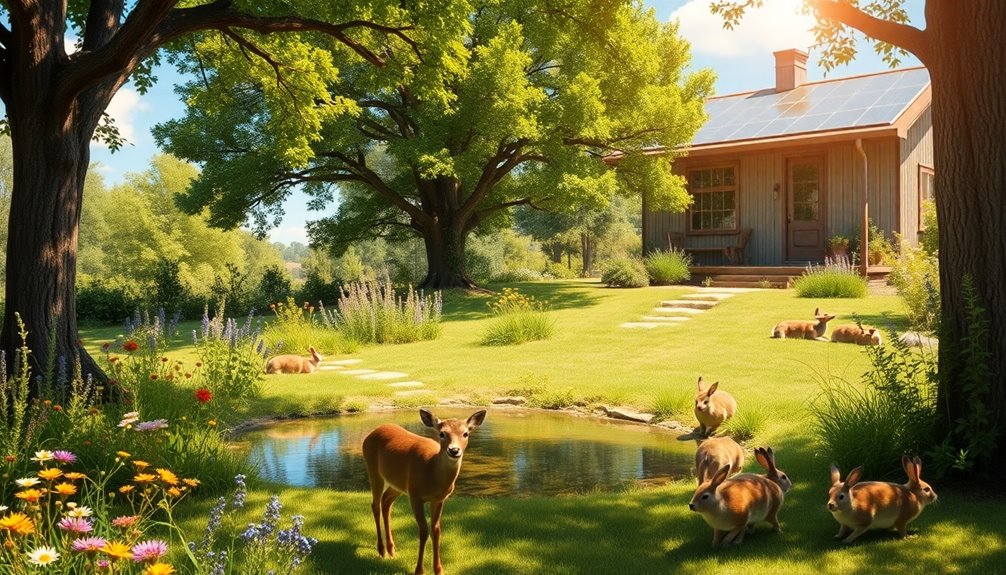
Wildlife habitats play a crucial role in maintaining the balance of our ecosystems, especially as urbanization and development encroach on natural landscapes. Understanding wildlife habitat importance is essential for sustainable living.
By integrating wildlife-friendly practices on your property, you can create spaces that support beneficial insects and other species vital for pest control and pollination. These practices not only enhance biodiversity but also boost the resilience of agricultural crops.
When you foster habitats, you help every single aspect of the ecosystem thrive, leading to resilient food systems that benefit both your home and the wildlife around you. Embracing coexistence strategies ensures that you contribute to the health of wildlife populations while promoting sustainable land management for future generations.
Wildlife as Food Sources
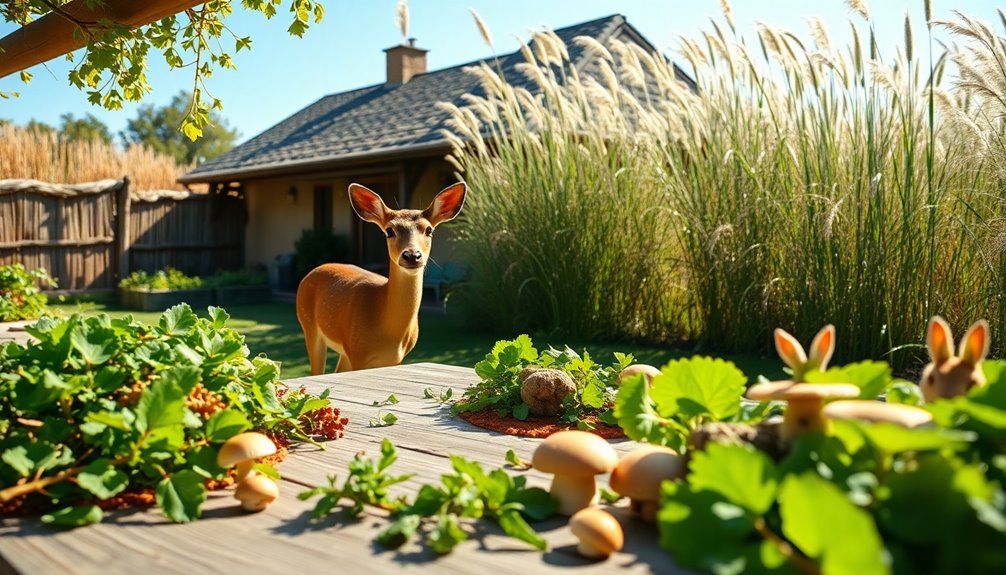
When you consider wildlife as a food source, it's important to recognize how biodiversity supports ecosystem stability.
Understanding local wildlife behavior patterns can help you make informed decisions about hunting and foraging practices.
Biodiversity Supports Ecosystem Stability
Biodiversity plays a crucial role in supporting ecosystem stability, particularly through its provision of diverse food sources.
When you embrace biodiversity in your sustainable home, you help create a balanced ecosystem that relies on interconnected food webs. These webs involve predators, herbivores, and plants, all contributing to nutrient cycling and energy flow.
By fostering healthy wildlife populations, like birds and beneficial insects, you enhance pest control and pollination, directly boosting your agricultural productivity. Farms that adopt wildlife-friendly practices see increased crop yields and fewer pests.
Furthermore, biodiverse habitats promote essential ecosystem services such as soil health and water purification, vital for sustainable agriculture and your well-being. Incorporating wildlife-friendly practices into your gardening can further enhance these benefits.
Ultimately, supporting biodiversity ensures resilience against environmental changes.
Local Wildlife Behavior Patterns
Understanding the behavior patterns of local wildlife can significantly enhance your sustainable gardening efforts.
For instance, deer and rabbits might munch on your crops, so implementing protective measures like fencing or companion planting can deter them effectively.
Predators like coyotes and foxes play a vital role by controlling rodent populations, preventing them from becoming a nuisance.
Additionally, birds, especially nesting owls, can consume thousands of rodents, benefiting your garden immensely.
Pay attention to seasonal behavior, like bears foraging in late summer, to manage food sources wisely and minimize unwanted encounters.
Furthermore, using well-seasoned wood in your wood-burning stove can help create a sustainable and efficient heating source while enjoying the comforting atmosphere it provides.
Wildlife-Friendly Landscaping Ideas
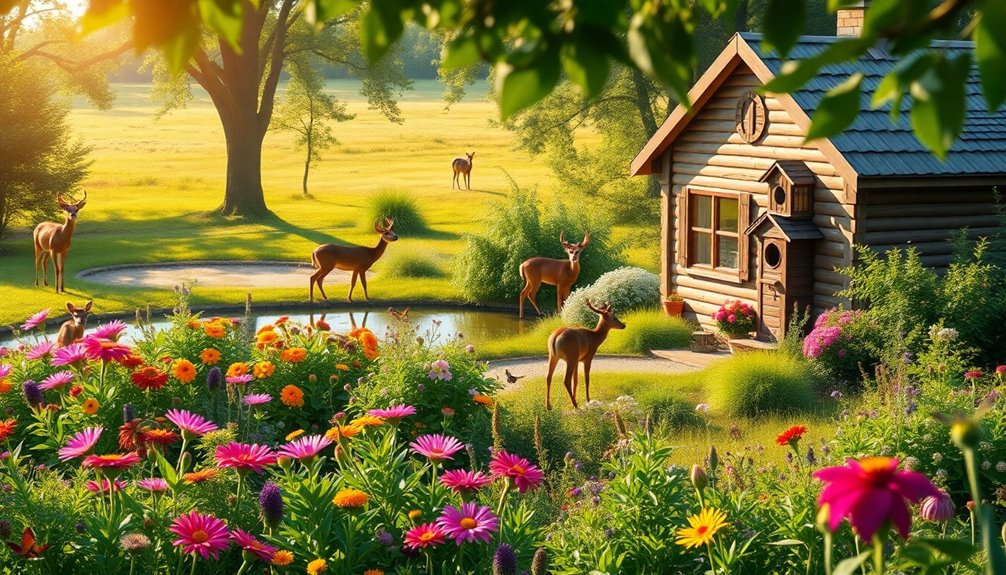
Creating a wildlife-friendly landscape not only enhances the beauty of your home but also supports local ecosystems.
Start by incorporating native plants, which attract local wildlife and provide essential food and shelter, promoting biodiversity.
Consider installing birdhouses and nesting boxes to invite various bird species that aid in pest control and pollination, improving your garden's health.
Water features like small ponds or birdbaths offer hydration sources, encouraging beneficial species such as frogs and insects.
Planting hedgerows or shrubs along property edges can create safe wildlife corridors, helping animals move while protecting your garden.
Finally, avoid chemical pesticides and herbicides; this wildlife-friendly landscaping approach fosters a healthier ecosystem for every living thing in your yard. Additionally, consider incorporating water features such as small ponds or birdbaths, which provide hydration and attract diverse wildlife.
Wildlife Conservation Organizations
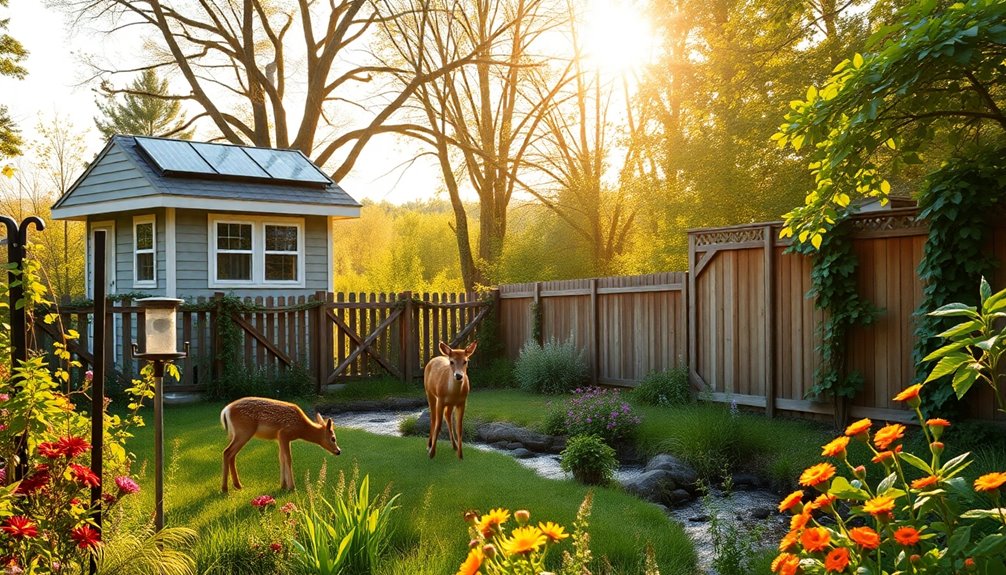
Wildlife-friendly landscaping is just one way you can contribute to the health of local ecosystems. By supporting wildlife conservation organizations, you help protect endangered species and their habitats.
With over 1 million species at risk of extinction, these organizations play a crucial role in implementing recovery plans, such as those mandated by the Endangered Species Act (ESA). Initiatives like the Yellowstone to Yukon Conservation Initiative promote wildlife connectivity, allowing safe movement between habitats.
Additionally, wildlife rehabilitation centers supported by these organizations educate the public about local wildlife, fostering responsible interactions. Engaging in community volunteering with wildlife conservation organizations can significantly enhance habitat restoration efforts and promote sustainable land management practices, ensuring a healthier environment for all creatures.
Wildlife-Friendly Building Materials
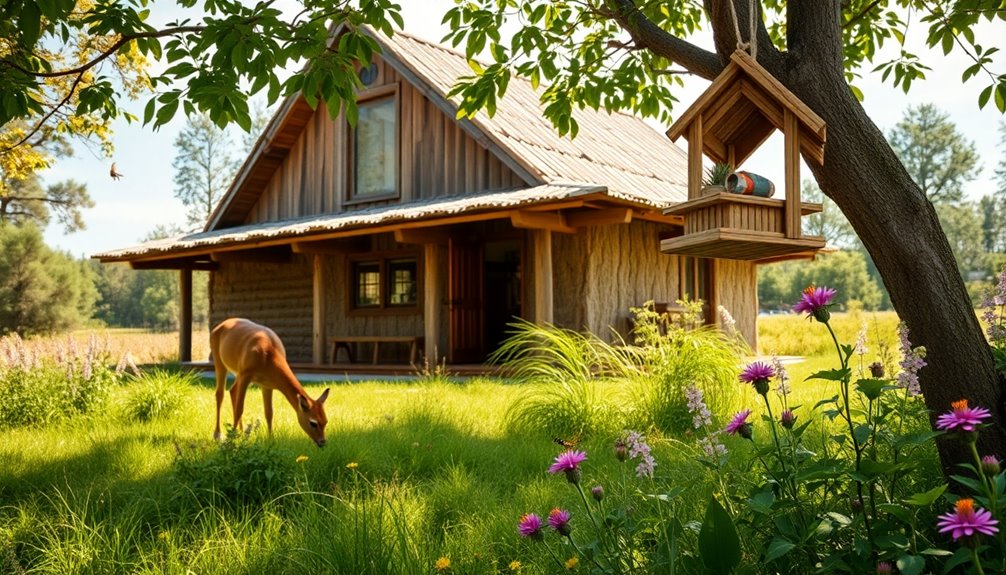
Building a home that harmonizes with nature starts with choosing the right materials.
Opt for wildlife-friendly building materials like reclaimed wood, which not only cuts down on deforestation but also provides natural insulation and unique character.
Incorporating natural stone enhances thermal mass, regulating indoor temperatures while blending into the habitat.
Consider eco-friendly insulation options like sheep's wool or recycled cellulose to minimize your carbon footprint and create healthier living spaces.
Energy-efficient windows with low-emissivity coatings help maintain a comfortable climate and deter wildlife from seeking shelter inside.
Finally, choose non-toxic paints and finishes to prevent harmful chemicals from leaching into the environment, ensuring a safer habitat for local wildlife.
Your choices can make a real difference!
Conflict With Local Wildlife
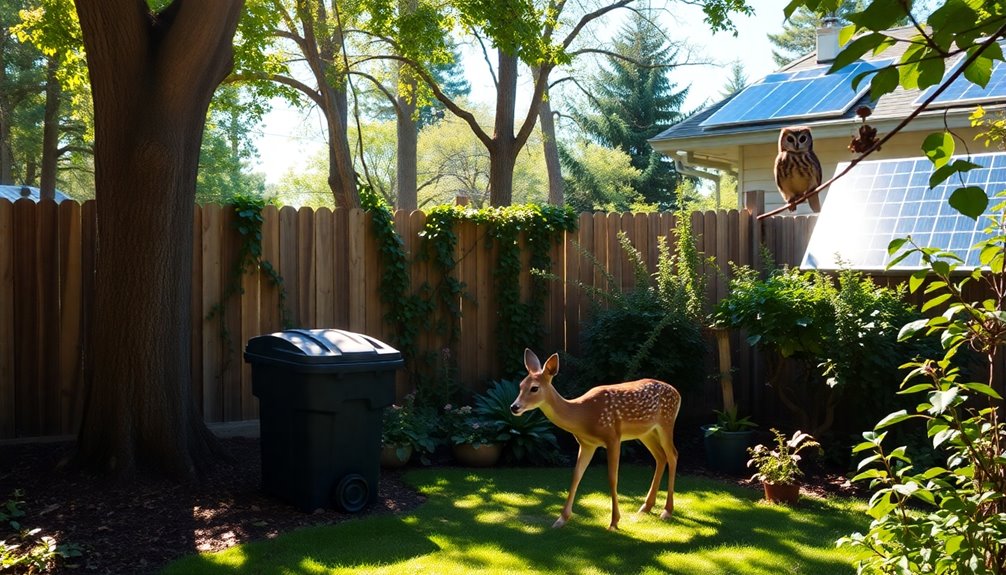
As you create a sustainable home, consider how native plants can attract beneficial wildlife while minimizing conflicts.
Implementing wildlife-friendly fencing solutions can also protect your property without harming the local ecosystem.
Native Plant Benefits
Often, incorporating native plants into your landscaping can significantly benefit local wildlife while minimizing potential conflicts. These plants provide essential food and habitat for pollinators like bees and butterflies, which are vital for a healthy ecosystem and successful crop production. By using native plants, you reduce the need for chemical pesticides since they're adapted to local conditions and naturally resist pests. This promotes biodiversity, creating a balanced environment where various species thrive, enhancing your agricultural productivity. Additionally, native plants require less water and maintenance, aligning perfectly with off-grid living principles. Some even deter unwanted wildlife by offering less appealing food options, helping you coexist peacefully with local fauna while still enjoying your sustainable home. Moreover, embracing self-care practices can further strengthen your connection to nature and promote mental well-being.
Wildlife-Friendly Fencing Solutions
Creating effective wildlife-friendly fencing solutions is crucial for maintaining harmony between agricultural practices and local fauna. By designing fences that minimize wildlife mortality, you can protect both your crops and the creatures of Mother Earth.
Hot wire fencing works wonders in deterring larger predators while allowing smaller wildlife to pass freely. Consider using temporary fencing to safeguard valuable crops without restricting animal movement, fostering a balanced ecosystem.
Installing lower-height fences or those with gaps can help maintain wildlife corridors, ensuring species can traverse your land safely. Additionally, opting for natural materials that blend into the environment can create less disruptive barriers, promoting coexistence strategies that benefit both farmers and local wildlife.
Your choices can lead to a sustainable future for all. Furthermore, implementing energy-efficient technology can enhance your agricultural practices while benefiting the environment.
Successful Urban Wildlife Gardens
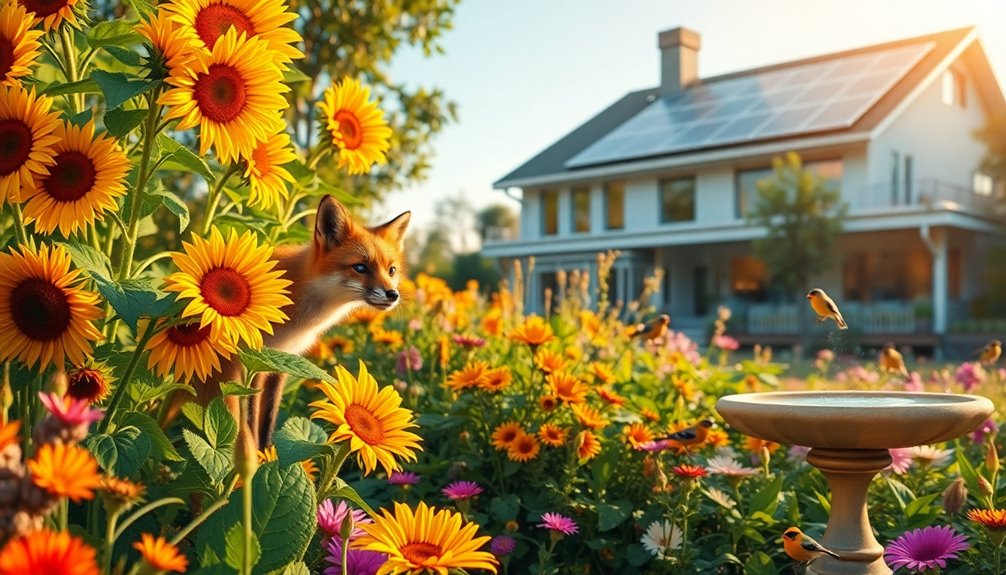
Successful urban wildlife gardens are vital in promoting biodiversity and fostering a healthier ecosystem right in your neighborhood. By incorporating native plants, you provide essential food and habitat for local wildlife, attracting pollinators and birds.
Creating layered plant structures with shrubs and trees enhances the variety of species you might see. Hedgerows can serve as wildlife corridors, helping animals navigate urban spaces safely.
Adding water features like bird baths or small ponds offers hydration sources, further supporting wildlife. Avoiding pesticides and herbicides helps maintain healthy populations of beneficial insects.
Lastly, implementing composting practices enriches soil health, creating a vibrant garden ecosystem that naturally controls pests and invites diverse wildlife to thrive alongside you. Additionally, using non-toxic materials in your garden can support a safer environment for wildlife and promote overall ecosystem health.
Conclusion
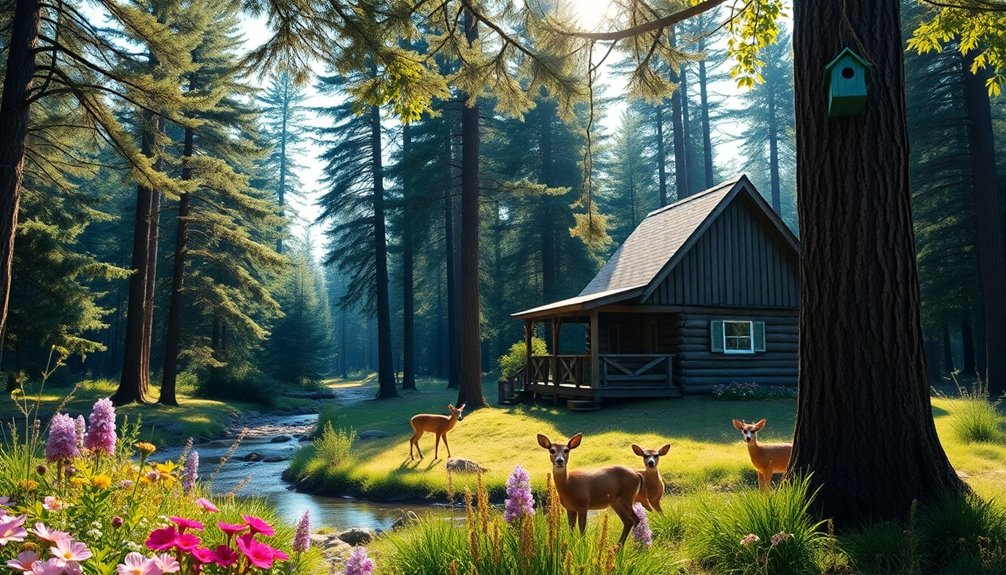
Coexisting with wildlife in sustainable homes not only benefits local ecosystems but also enriches your living experience. By fostering a symbiotic relationship with local fauna, you enhance biodiversity, creating a vibrant environment that supports various species.
Implementing wildlife-friendly landscaping and natural habitats encourages animals to thrive while reducing conflicts. Educating yourself about local wildlife behaviors helps you interact responsibly, minimizing risks and promoting harmony.
Utilizing sustainable practices like organic gardening and natural pest control supports soil health and biodiversity, making your off-grid space more resilient. Regularly monitoring wildlife interactions and adapting to seasonal changes enables you to manage challenges effectively.
Embracing this coexistence leads to a fulfilling lifestyle that honors nature while cultivating a sustainable home.
Additional Resources
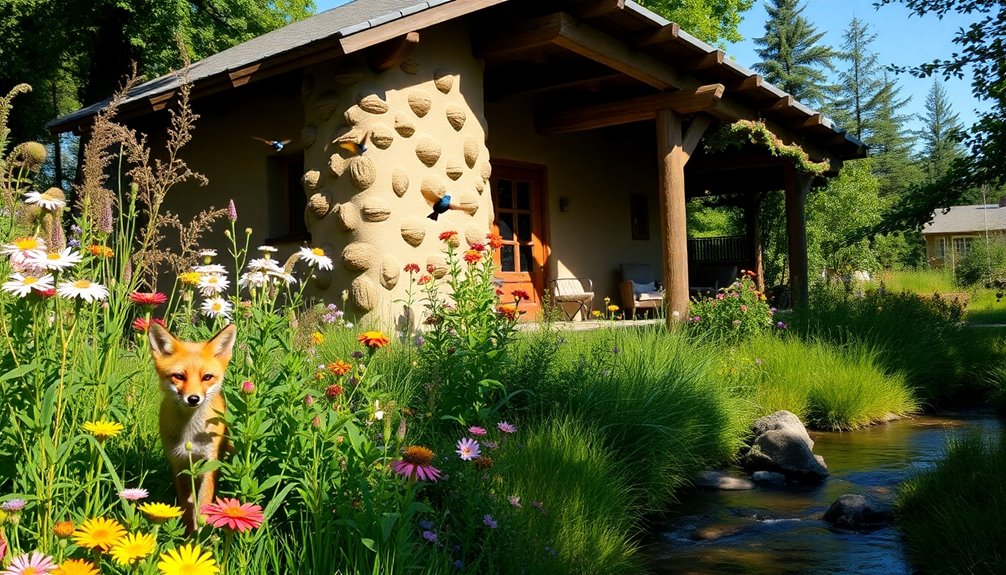
To enhance your understanding of wildlife coexistence, several valuable resources are available that can guide you in fostering a harmonious relationship with local animals.
Consider visiting wildlife rehabilitation centers like Procyon Wildlife, which offer educational resources and volunteer opportunities. Local seminars on wildlife behavior can raise awareness about risks and encourage responsible interactions.
Educational outreach programs provide informative presentations and newsletters, keeping you engaged in conservation efforts. Additionally, wildlife-friendly gardening guides are essential for creating habitats that support local fauna while reducing conflicts.
Online platforms and community groups focused on wildlife conservation also offer insights and foster discussions about best practices. Utilizing these resources will empower you to live sustainably alongside wildlife and enhance your efforts in composting for soil health, which further supports local ecosystems.
Frequently Asked Questions
How Can We Coexist With Wildlife?
To coexist with wildlife, you can start by creating a welcoming environment for them.
Plant native species and add natural shelters to support local fauna.
Observe animals from a distance to reduce their stress and allow them to thrive.
Regularly check your property for potential nesting spots to avoid conflicts.
Implement fencing and consider using livestock guardian dogs to protect your pets while letting wildlife roam freely.
This way, you foster harmony in your surroundings.
How to Make Your House Wildlife Friendly?
To make your house wildlife-friendly, start by planting native plants that attract local species.
Install bird feeders and nesting boxes to encourage birds, which help with pest control.
Leave some dead trees and brush piles; they create natural habitats.
Use fencing that allows smaller wildlife to pass through while protecting your garden.
Lastly, add water features like ponds to support amphibians and beneficial insects, enhancing biodiversity around your home.
How Do You Keep Wild Animals Away From Your House?
To keep wild animals away from your house, start by securing trash bins and storing pet food properly to eliminate food odors.
Install fencing around gardens to deter larger animals and use natural repellents like citrus or vinegar.
Seal gaps in your home's foundation and windows to block small animals.
Finally, landscape thoughtfully by planting native species and thorny bushes to create natural barriers that discourage wildlife from approaching your property.
How to Connect With Wild Animals?
To connect with wild animals, start by creating a welcoming environment with native plants and water sources.
Set up bird feeders and nesting boxes to attract birds, which can enhance your garden's ecosystem.
Spend time observing their behavior from a distance; this builds trust and lets you appreciate their unique patterns.
Join local wildlife education programs to learn more about the species around you and discover how to engage with them responsibly.

